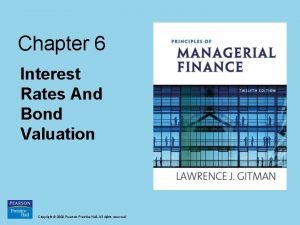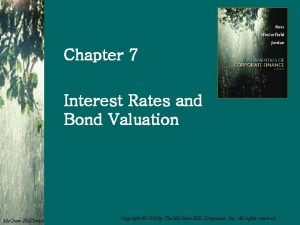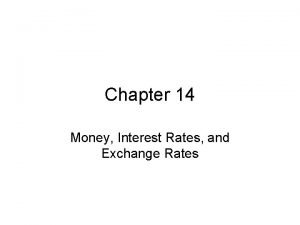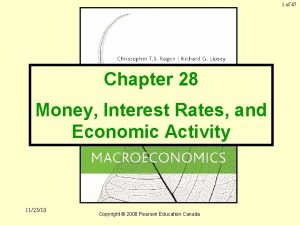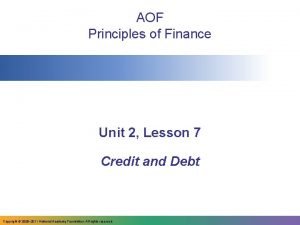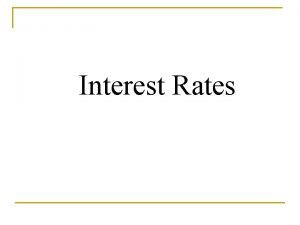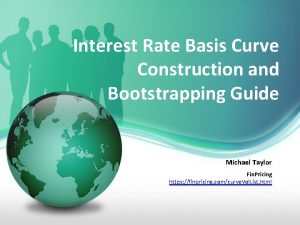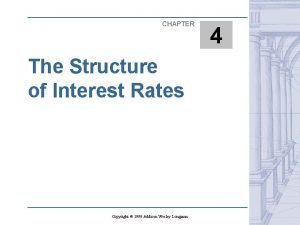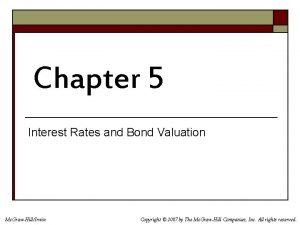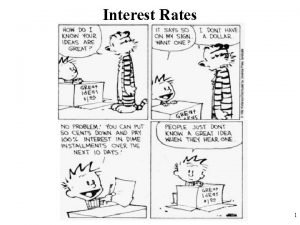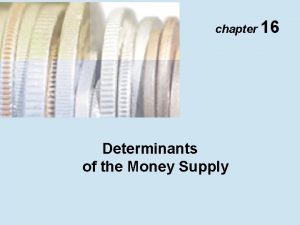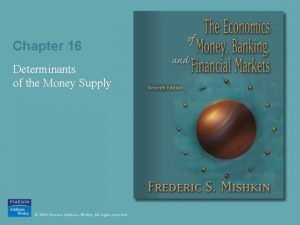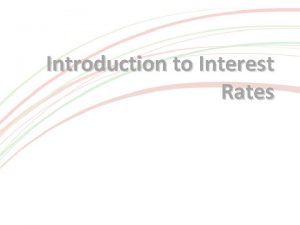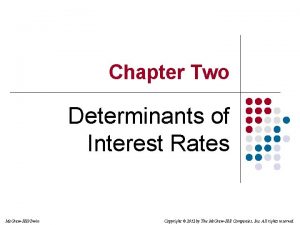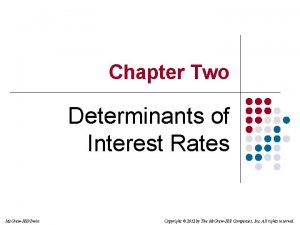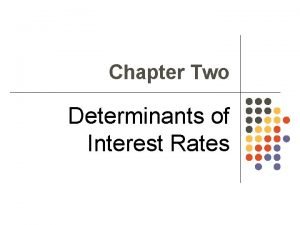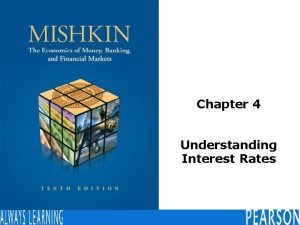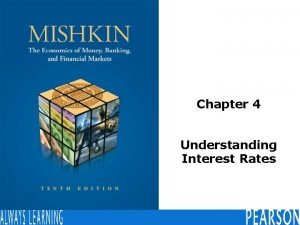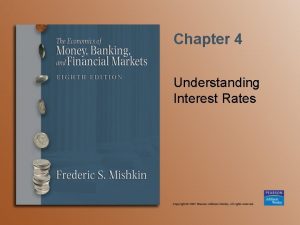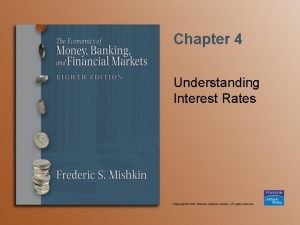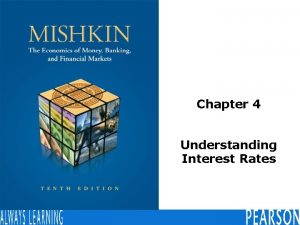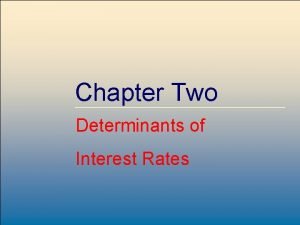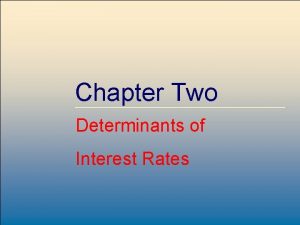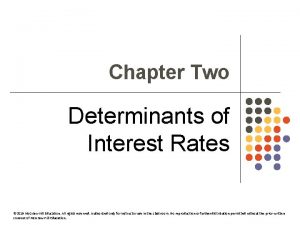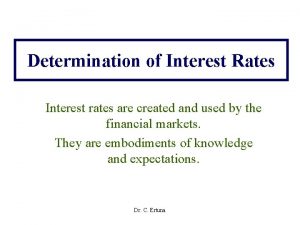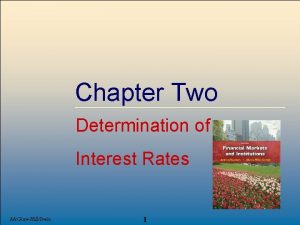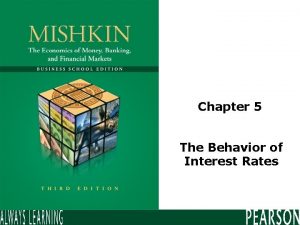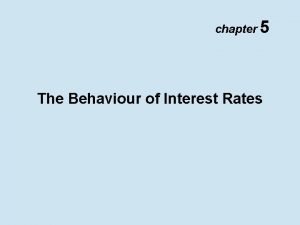Chapter Two Determinants of Interest Rates Mc GrawHillIrwin



























- Slides: 27

Chapter Two Determinants of Interest Rates Mc. Graw-Hill/Irwin 1 © 2007, The Mc. Graw-Hill Companies, All Rights Reserved

Interest Rate Fundamentals • Nominal interest rates - the interest rate actually observed in financial markets – directly affect the value (price) of most securities traded in the market – affect the relationship between spot and forward FX rates Mc. Graw-Hill/Irwin 2 © 2007, The Mc. Graw-Hill Companies, All Rights Reserved

Time Value of Money and Interest Rates • Assumes the basic notion that a dollar received today is worth more than a dollar received at some future date • Compound interest – interest earned on an investment is reinvested • Simple interest – interest earned on an investment is not reinvested Mc. Graw-Hill/Irwin 3 © 2007, The Mc. Graw-Hill Companies, All Rights Reserved

Calculation of Simple Interest Value = Principal + Interest (year 1) + Interest (year 2) Example: $1, 000 to invest for a period of two years at 12 percent Value = $1, 000 + $1, 000(. 12)(2) = $1, 240 Mc. Graw-Hill/Irwin 4 © 2007, The Mc. Graw-Hill Companies, All Rights Reserved

Value of Compound Interest Value = Principal + Interest + Compounded interest Value = $1, 000 + $1, 000(. 12) = $1, 000[1 + 2(. 12) + (. 12)2] = $1, 000(1. 12)2 = $1, 254. 40 Mc. Graw-Hill/Irwin 5 © 2007, The Mc. Graw-Hill Companies, All Rights Reserved

Present Value of a Lump Sum • PV function converts cash flows received over a future investment horizon into an equivalent (present) value by discounting future cash flows back to present using current market interest rate – lump sum payment – annuity • PVs decrease as interest rates increase Mc. Graw-Hill/Irwin 6 © 2007, The Mc. Graw-Hill Companies, All Rights Reserved

Calculating Present Value (PV) of a Lump Sum PV = FVn(1/(1 + i/m))nm = FVn(PVIFi/m, nm) where: PV = present value FV = future value (lump sum) received in n years i = simple annual interest rate earned n = number of years in investment horizon m = number of compounding periods in a year i/m = periodic rate earned on investments nm = total number of compounding periods PVIF = present value interest factor of a lump sum Mc. Graw-Hill/Irwin 7 © 2007, The Mc. Graw-Hill Companies, All Rights Reserved

Calculating Present Value of a Lump Sum • You are offered a security investment that pays $10, 000 at the end of 6 years in exchange for a fixed payment today. PV = FV(PVIFi/m, nm) • • at 8% interest - = $10, 000(0. 630170) = $6, 301. 70 • at 12% interest - = $10, 000(0. 506631) = $5, 066. 31 • at 16% interest - = $10, 000(0. 410442) = $4, 104. 42 Mc. Graw-Hill/Irwin 8 © 2007, The Mc. Graw-Hill Companies, All Rights Reserved

Calculation of Present Value (PV) of an Annuity nm PV = PMT (1/(1 + i/m))t = PMT(PVIFA i/m, nm) t=1 where: PV = present value PMT = periodic annuity payment received during investment horizon i/m = periodic rate earned on investments nm = total number of compounding periods PVIFA = present value interest factor of an annuity Mc. Graw-Hill/Irwin 9 © 2007, The Mc. Graw-Hill Companies, All Rights Reserved

Calculation of Present Value of an Annuity You are offered a security investment that pays $10, 000 on the last day of every year for the next 6 years in exchange for a fixed payment today. PV = PMT(PVIFAi/m, nm) at 8% interest - = $10, 000(4. 622880) = $46, 228. 80 If the investment pays on the last day of every quarter for the next six years at 8% interest - = $10, 000(18. 913926) = $189, 139. 26 Mc. Graw-Hill/Irwin 10 © 2007, The Mc. Graw-Hill Companies, All Rights Reserved

Future Values • Translate cash flows received during an investment period to a terminal (future) value at the end of an investment horizon • FV increases with both the time horizon and the interest rate Mc. Graw-Hill/Irwin 11 © 2007, The Mc. Graw-Hill Companies, All Rights Reserved

Future Values Equations FV of lump sum equation FVn = PV(1 + i/m)nm = PV(FVIF i/m, nm) FV of annuity payment equation (nm-1) FVn = PMT (1 + i/m)t = PMT(FVIFAi/m, mn) (t = 0) Mc. Graw-Hill/Irwin 12 © 2007, The Mc. Graw-Hill Companies, All Rights Reserved

Calculation of Future Value of a Lump Sum • You invest $10, 000 today in exchange for a fixed payment at the end of six years – – at 8% interest = $10, 000(1. 586874) = $15, 868. 74 at 12% interest = $10, 000(1. 973823) = $19, 738. 23 at 16% interest = $10, 000(2. 436396) = $24, 363. 96 at 16% interest compounded semiannually • = $10, 000(2. 518170) = $25, 181. 70 Mc. Graw-Hill/Irwin 13 © 2007, The Mc. Graw-Hill Companies, All Rights Reserved

Calculation of the Future Value of an Annuity • You invest $10, 000 on the last day of every year for the next six years, – at 8% interest = $10, 000(7. 335929) = $73, 359. 29 • If the investment pays you $10, 000 on the last day of every quarter for the next six years, – FV = $10, 000(30. 421862) = $304, 218. 62 • If the annuity is paid on the first day of each quarter, – FV = $10, 000(31. 030300) = $310, 303. 00 Mc. Graw-Hill/Irwin 14 © 2007, The Mc. Graw-Hill Companies, All Rights Reserved

Relation between Interest Rates and Present and Future Values Present Value (PV) Future Value (FV) Interest Rate Mc. Graw-Hill/Irwin 15 © 2007, The Mc. Graw-Hill Companies, All Rights Reserved

Effective or Equivalent Annual Return (EAR) Rate earned over a 12 – month period taking the compounding of interest into account. EAR = (1 + r) c – 1 Where c = number of compounding periods per year Mc. Graw-Hill/Irwin 16 © 2007, The Mc. Graw-Hill Companies, All Rights Reserved

Loanable Funds Theory • A theory of interest rate determination that views equilibrium interest rates in financial markets as a result of the supply and demand for loanable funds Mc. Graw-Hill/Irwin 17 © 2007, The Mc. Graw-Hill Companies, All Rights Reserved

Supply of Loanable Funds Interest Rate Demand Supply Quantity of Loanable Funds Supplied and Demanded Mc. Graw-Hill/Irwin 18 © 2007, The Mc. Graw-Hill Companies, All Rights Reserved

Funds Supplied and Demanded by Various Groups (in billions of dollars) Funds Supplied Funds Demanded Households Business - nonfinancial Business - financial Government units Foreign participants Mc. Graw-Hill/Irwin $34, 860. 7 12, 679. 2 31, 547. 9 12, 574. 5 8, 426. 7 19 $15, 197. 4 30, 779. 2 45061. 3 6, 695. 2 2, 355. 9 Net $19, 663. 3 -12, 100. 0 -13, 513. 4 5, 879. 3 6, 070. 8 © 2007, The Mc. Graw-Hill Companies, All Rights Reserved

Determination of Equilibrium Interest Rates D S Interest Rate IH i E IL Q Mc. Graw-Hill/Irwin 20 Quantity of Loanable Funds Supplied and Demanded © 2007, The Mc. Graw-Hill Companies, All Rights Reserved

Effect on Interest rates from a Shift in the Demand Curve for or Supply curve of Loanable Funds Increased supply of loanable funds Increased demand for loanable funds Interest Rate SS DD DD SS* i* E E* i** Q* Q** Mc. Graw-Hill/Irwin i* Quantity of Funds Supplied 21 DD* E Q* Q** SS E* Quantity of Funds Demanded © 2007, The Mc. Graw-Hill Companies, All Rights Reserved

Factors Affecting Nominal Interest Rates • • • Inflation Real Interest Rate Default Risk Liquidity Risk Special Provisions Term to Maturity Mc. Graw-Hill/Irwin 22 © 2007, The Mc. Graw-Hill Companies, All Rights Reserved

Inflation and Interest Rates: The Fisher Effect The interest rate should compensate an investor for both expected inflation and the opportunity cost of foregone consumption (the real rate component) i = RIR + Expected(IP) RIR = i – Expected(IP) or Example: 3. 49% - 1. 60% = 1. 89% Mc. Graw-Hill/Irwin 23 © 2007, The Mc. Graw-Hill Companies, All Rights Reserved

Default Risk and Interest Rates The risk that a security’s issuer will default on that security by being late on or missing an interest or principal payment DRPj = ijt - i. Tt Example for December 2003: DRPAaa = 5. 66% - 4. 01% = 1. 65% DRPBaa = 6. 76% - 4. 01% = 2. 75% Mc. Graw-Hill/Irwin 24 © 2007, The Mc. Graw-Hill Companies, All Rights Reserved

Term to Maturity and Interest Rates: Yield Curve (a) Upward sloping (b) Inverted or downward sloping (c) Flat Yield to Maturity (a) (c) (b) Time to Maturity Mc. Graw-Hill/Irwin 25 © 2007, The Mc. Graw-Hill Companies, All Rights Reserved

Term Structure of Interest Rates • Unbiased Expectations Theory • Liquidity Premium Theory • Market Segmentation Theory Mc. Graw-Hill/Irwin 26 © 2007, The Mc. Graw-Hill Companies, All Rights Reserved

Forecasting Interest Rates Forward rate is an expected or “implied” rate on a security that is to be originated at some point in the future using the unbiased expectations theory _ _ 1/2 - 1 R = [(1 + R )(1 + ( f ))] 1 2 1 where 2 f 1 Mc. Graw-Hill/Irwin = expected one-year rate for year 2, or the implied forward one-year rate for next year 27 © 2007, The Mc. Graw-Hill Companies, All Rights Reserved
 Determinants of interest rates
Determinants of interest rates Chapter 7 interest rates and bond valuation
Chapter 7 interest rates and bond valuation Chapter 5 bonds bond valuation and interest rates solutions
Chapter 5 bonds bond valuation and interest rates solutions Chapter 6 interest rates and bond valuation
Chapter 6 interest rates and bond valuation Chapter 7 interest rates and bond valuation
Chapter 7 interest rates and bond valuation Chapter 6 interest rates and bond valuation
Chapter 6 interest rates and bond valuation Unit rate
Unit rate Ratios rates and unit rates guided notes
Ratios rates and unit rates guided notes Ratios rates and unit rates
Ratios rates and unit rates Ratios rates and unit rates
Ratios rates and unit rates Interest rates and economic growth
Interest rates and economic growth Graphing monetary and fiscal policy interactions
Graphing monetary and fiscal policy interactions Financial risk definition
Financial risk definition Interest rate quotes
Interest rate quotes Interest rates and price level
Interest rates and price level Interest rates and price level
Interest rates and price level Effective versus nominal interest rates
Effective versus nominal interest rates Unit 2 lesson 12 interest rates
Unit 2 lesson 12 interest rates Real vs nominal interest rate
Real vs nominal interest rate Interest rates
Interest rates Bootstrapping interest rates
Bootstrapping interest rates Interest rates
Interest rates Interest rates
Interest rates Interest rate effect
Interest rate effect Simple interest
Simple interest Knowledge readiness to learn
Knowledge readiness to learn Chapter 16 determinants of the money supply
Chapter 16 determinants of the money supply Chapter 16 determinants of the money supply
Chapter 16 determinants of the money supply



